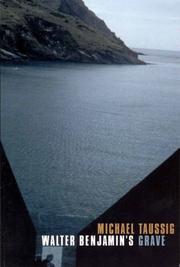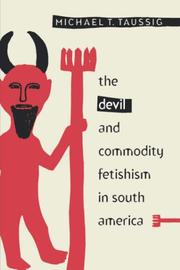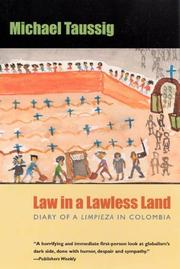| Listing 1 - 10 of 12 | << page >> |
Sort by
|

ISBN: 0226790037 0226790045 9780226790046 9780226790039 Year: 2006 Publisher: Chicago University of Chicago press
Abstract | Keywords | Export | Availability | Bookmark
 Loading...
Loading...Choose an application
- Reference Manager
- EndNote
- RefWorks (Direct export to RefWorks)
In September 1940, Walter Benjamin committed suicide in Port Bou on the Spanish-French border when it appeared that he and his travelling partners would be denied passage into Spain in their attempt to escape the Nazis. In 2002, one of anthropology's& and indeed today's& most distinctive writers, Michael Taussig, visited Benjamin's grave in Port Bou. The result is & Walter Benjamin's Grave,& a moving essay about the cemetery, eyewitness accounts of Benjamin's border travails, and the circumstances of his demise. It is the most recent of eight revelatory essays collected in this volume of the same name.& Looking over these essays written over the past decade,& writes Taussig, & I think what they share is a love of muted and defective storytelling as a form of analysis. Strange love indeed; love of the wound, love of the last gasp.& Although thematically these essays run the gamut& covering the monument and graveyard at Port Bou, discussions of peasant poetry in Colombia, a pact with the devil, the peculiarities of a shaman's body, transgression, the disappearance of the sea, New York City cops, and the relationship between flowers and violence& each shares Taussig's highly individual brand of storytelling, one that depends on a deep appreciation of objects and things as a way to retrieve even deeper philosophical and anthropological meanings. Whether he finds himself in Australia, Colombia, Manhattan, or Spain, in the midst of a book or a beach, whether talking to friends or staring at a monument, Taussig makes clear through these marvelous essays that materialist knowledge offers a crucial alternative to the increasingly abstract, globalized, homogenized, and digitized world we inhabit.Pursuing an adventure that is part ethnography, part autobiography, and part cultural criticism refracted through the object that is Walter Benjamin's grave, Taussig, with this collection, provides his own literary memorial to the twentieth century's greatest cultural critic.
Anthropology --- Fieldwork --- Philosophy --- Benjamin, Walter, --- #SBIB:39A2 --- Antropologie: methoden en technieken --- Fieldwork. --- Field work. --- Anthropology - Fieldwork. --- Anthropology -- Fieldwork. --- Social Sciences --- Anthropology - General --- Anthropology - Fieldwork --- Anthropology - Philosophy --- Benjamin, Walter, - 1892-1940
Book
ISBN: 9780226789828 9780226789835 0226789829 0226789837 9786613297662 6613297666 Year: 2011 Publisher: Chicago London The University of Chicago Press
Abstract | Keywords | Export | Availability | Bookmark
 Loading...
Loading...Choose an application
- Reference Manager
- EndNote
- RefWorks (Direct export to RefWorks)
'I Swear I Saw This' records visionary anthropologist Michael Taussig's reflections on the fieldwork notebooks he kept through 40 years of travels in Colombia.
Anthropology --- Anthropological illustration. --- #SBIB:39A2 --- Illustration, Anthropological --- Scientific illustration --- Fieldwork. --- Methodology. --- Antropologie: methoden en technieken --- Anthropological illustration --- Fieldwork --- Methodology --- Anthropologie --- Illustration anthropologique --- Recherche sur le terrain --- Méthodologie --- Anthropology - Fieldwork --- Anthropology - Methodology

ISBN: 0807841064 0807814121 Year: 1983 Publisher: Chapel Hill University of North Carolina press
Abstract | Keywords | Export | Availability | Bookmark
 Loading...
Loading...Choose an application
- Reference Manager
- EndNote
- RefWorks (Direct export to RefWorks)
299.6*8 --- 299.6*8 Godsdiensten van de zwarten in Midden- en Zuid-Amerika. Voodoo --- Godsdiensten van de zwarten in Midden- en Zuid-Amerika. Voodoo --- Economic development --- Plantations --- Superstition --- Tin mines and mining --- #SBIB:39A10 --- #SBIB:39A74 --- Stannaries --- Mines and mineral resources --- Tin industry --- Folk beliefs --- Traditions --- Folklore --- Religion --- Farms --- Development, Economic --- Economic growth --- Growth, Economic --- Economic policy --- Economics --- Statics and dynamics (Social sciences) --- Development economics --- Resource curse --- Social aspects&delete& --- Case studies --- Antropologie: religie, riten, magie, hekserij --- Etnografie: Amerika --- Développement économique --- Etain --- Social aspects --- Case studies. --- Aspect social --- Cas, Etudes de --- Mines et extraction
Book
ISBN: 0807871338 146960423X 0807898414 9780807898413 9781469604237 9780807871331 9798893134551 Year: 2010 Publisher: Chapel Hill [N.C.] University of North Carolina Press
Abstract | Keywords | Export | Availability | Bookmark
 Loading...
Loading...Choose an application
- Reference Manager
- EndNote
- RefWorks (Direct export to RefWorks)
In this classic book, Michael Taussig explores the social significance of the devil in the folklore of contemporary plantation workers and miners in South America. Grounding his analysis in Marxist theory, Taussig finds that the fetishization of evil, in the image of the devil, mediates the conflict between precapitalist and capitalist modes of objectifying the human condition. He links traditional narratives of the devil-pact, in which the soul is bartered for illusory or transitory power, with the way in which production in capitalist economies causes workers to become alienated from the com
Economic development --- Plantations --- Tin mines and mining --- Superstition --- Folk beliefs --- Traditions --- Folklore --- Religion --- Stannaries --- Mines and mineral resources --- Tin industry --- Farms --- Development, Economic --- Economic growth --- Growth, Economic --- Economic policy --- Economics --- Statics and dynamics (Social sciences) --- Development economics --- Resource curse --- Social aspects --- E-books --- Fétichisme --- --Plantations --- Moeurs --- --Colombie --- --Amérique du Sud --- --History --- Bolivia. --- Plantations - Latin America - History --- Economic development - Latin America --- Colombie --- Amérique du Sud
Book
Year: 1986 Publisher: Chicago (Ill.): University of Chicago press,
Abstract | Keywords | Export | Availability | Bookmark
 Loading...
Loading...Choose an application
- Reference Manager
- EndNote
- RefWorks (Direct export to RefWorks)
Indians of South America --- Shamanism --- Rubber industry and trade --- Colombia --- Putumayo (Colombia : Intendancy)
Book
ISBN: 9780226789866 9780226789859 0226789853 0226789861 Year: 2012 Publisher: Chicago: University of Chicago press,
Abstract | Keywords | Export | Availability | Bookmark
 Loading...
Loading...Choose an application
- Reference Manager
- EndNote
- RefWorks (Direct export to RefWorks)

ISBN: 9780226790145 0226790142 Year: 2005 Publisher: Chicago, Ill.: University of Chicago press,
Abstract | Keywords | Export | Availability | Bookmark
 Loading...
Loading...Choose an application
- Reference Manager
- EndNote
- RefWorks (Direct export to RefWorks)
Violence --- Paramilitary forces --- Death squads --- Terrorism
Book
ISBN: 022651627X Year: 2018 Publisher: Chicago ; London : The University of Chicago Press,
Abstract | Keywords | Export | Availability | Bookmark
 Loading...
Loading...Choose an application
- Reference Manager
- EndNote
- RefWorks (Direct export to RefWorks)
“It is the contemporary elixir from which all manner of being emerges, the metamorphic sublime, an alchemist’s dream.” So begins Palma Africana, the latest attempt by anthropologist Michael Taussig to make sense of the contemporary moment. But to what elixir does he refer? Palm oil. Saturating everything from potato chips to nail polish, palm oil has made its way into half of the packaged goods in our supermarkets. By 2020, world production will be double what it was in 2000. In Colombia, palm oil plantations are covering over one-time cornucopias of animal, bird, and plant life. Over time, they threaten indigenous livelihoods and give rise to abusive labor conditions and major human rights violations. The list of entwined horrors—climatic, biological, social—is long. But Taussig takes no comfort in our usual labels: “habitat loss,” “human rights abuses,” “climate change.” The shock of these words has passed; nowadays it is all a blur. Hence, Taussig’s keen attention to words and writing throughout this work. He takes cues from precursors’ ruminations: Roland Barthes’s suggestion that trees form an alphabet in which the palm tree is the loveliest; William Burroughs’s retort to critics that for him words are alive like animals and don’t like to be kept in pages—cut them and the words are let free. Steeped in a lifetime of philosophical and ethnographic exploration, Palma Africana undercuts the banality of the destruction taking place all around us and offers a penetrating vision of the global condition. Richly illustrated and written with experimental verve, this book is Taussig’s Tristes Tropiques for the twenty-first century.
Plantations --- Ethnology --- Palm oil industry --- Oil palm --- Environmental aspects --- Social aspects --- Economic aspects --- Taussig, Michael T. --- Colombia --- Environmental conditions. --- Social conditions. --- Colombia. --- Taussig. --- anthropology. --- deforestation. --- ethnography. --- habitat. --- palm oil. --- plantations.

ISBN: 0226790002 1282538195 9786612538193 9780226790008 9780226790039 0226790037 0226790037 0226790045 9780226790046 Year: 2006 Publisher: Chicago University of Chicago Press
Abstract | Keywords | Export | Availability | Bookmark
 Loading...
Loading...Choose an application
- Reference Manager
- EndNote
- RefWorks (Direct export to RefWorks)
In September 1940, Walter Benjamin committed suicide in Port Bou on the Spanish-French border when it appeared that he and his travelling partners would be denied passage into Spain in their attempt to escape the Nazis. In 2002, one of anthropology's-and indeed today's-most distinctive writers, Michael Taussig, visited Benjamin's grave in Port Bou. The result is "Walter Benjamin's Grave," a moving essay about the cemetery, eyewitness accounts of Benjamin's border travails, and the circumstances of his demise. It is the most recent of eight revelatory essays collected in this volume of the same name. "Looking over these essays written over the past decade," writes Taussig, "I think what they share is a love of muted and defective storytelling as a form of analysis. Strange love indeed; love of the wound, love of the last gasp." Although thematically these essays run the gamut-covering the monument and graveyard at Port Bou, discussions of peasant poetry in Colombia, a pact with the devil, the peculiarities of a shaman's body, transgression, the disappearance of the sea, New York City cops, and the relationship between flowers and violence-each shares Taussig's highly individual brand of storytelling, one that depends on a deep appreciation of objects and things as a way to retrieve even deeper philosophical and anthropological meanings. Whether he finds himself in Australia, Colombia, Manhattan, or Spain, in the midst of a book or a beach, whether talking to friends or staring at a monument, Taussig makes clear through these marvelous essays that materialist knowledge offers a crucial alternative to the increasingly abstract, globalized, homogenized, and digitized world we inhabit. Pursuing an adventure that is part ethnography, part autobiography, and part cultural criticism refracted through the object that is Walter Benjamin's grave, Taussig, with this collection, provides his own literary memorial to the twentieth century's greatest cultural critic.
Anthropology --- Fieldwork. --- port bou, suicide, walter benjamin, borders, nazis, escape, refugees, anthropology, cemetery, grave, monument, memorial, graveyard, colombia, poetry, peasant, class, poverty, shaman, transgression, flowers, violence, sea, police, new york, spain, manhattan, australia, materialism, ethnography, memoir, autobiography, biography, sociology.
Book
ISBN: 1913620182 9781913620189 Year: 2021 Publisher: London MACK
Abstract | Keywords | Export | Availability | Bookmark
 Loading...
Loading...Choose an application
- Reference Manager
- EndNote
- RefWorks (Direct export to RefWorks)
On the islands in the Strait of Hormuz, off the southern coast of Iran, there is a common belief that the winds can possess a person, bringing illness and disease. The existence of similar convictions in some African countries suggests that the cult may have been brought to Iran from southeast Africa through the Arab slave trade. This history is rarely spoken about but these winds and the traces they have left on the islands and their inhabitants are the touchstone for Hoda Afshar's Speak The Wind. Through her subtle and perceptive images of the extraordinary landscapes, the people and their rituals, Afshar's beautiful and complex book attempts to picture the wind and its psychic entanglements, to form a visible record of the invisible.
Photography, Artistic --- Winds --- History --- Afshar, Hoda, 1983 --- -Iran
| Listing 1 - 10 of 12 | << page >> |
Sort by
|

 Search
Search Feedback
Feedback About UniCat
About UniCat  Help
Help News
News